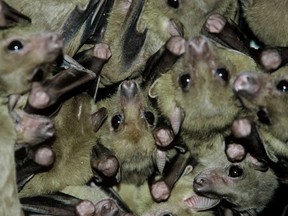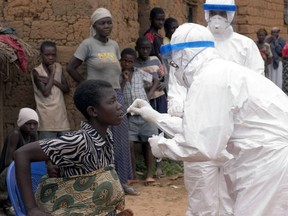Another Dread Zoonotic Surfacing in Africa
"Marburg is a highly infectious viral hemorrhagic fever in the same family as the more well-known Ebola virus disease.""In 2008, two independent cases were reported in travellers who visited a cave inhabited by Rousettus bat colonies in Uganda."World Health Organization"WHO is on the ground supporting health authorities [in Ghana where the latest outbreak has occurred] and now that the outbreak is declared, we are marshalling more resources for the response."Dr.Matshidiso Moeti, Regional Director for Africa, World Health Organization
 |
In
1967 two cases of the disease occurred, one in Marburg and Frankfurt,
Germany, the other in Belgrade, Serbia. This is the origin of the naming
of the virus; Marburg. The cases were traced back to a laboratory
working with African green monkeys that had been imported from Uganda.
The WHO reports that prolonged exposure to mines or caves where colonies
of bats live can result in human infection.
The
Ghana Health Service's Disease Surveillance Department recommends
certain steps in avoidance of contracting the virus; abstaining from
consuming bush meat; washing hands frequently with soap and water, and
taking care not to handle dead bodies of those who may have had the
Marburg virus. Timely and sterling recommendations for Africa, should
outbreaks continue to be confined to that continent.
The
suspected causes and such exposure leading to a virus leaping the
species barrier from wild animals to humans has a familiar ring to it
for most people; it was at the live animal market in Wuhan, China, that
transmission from animal [bats infecting commonly consumed mammals]
to human took place; bush animals sold for human consumption, infected
with SARS-CoV-2 transmitted it to people at large through contact in the
Huanan market.
 |
Marburg
virus is more vindictively fatal than COVID-19; an estimated 88 percent
of those infected may never recover. It has an incubation period
between two to 14 days. Infection can spread from person to person
through direct contact with bodily fluids. Clothing which has been worn
by someone infected with Marburg can also become a source of infection.
No cure exists for the virus, though treatment for its symptoms is
available.
Symptoms
of infection include high fever and severe headaches, muscle aches and
pains. Severe diarrhea, stomach pain, nausea and vomiting may begin on
the infection's third day. Those infected become extremely lethargic. In
cases that become fatal, a patient generally bleeds from the nose and
gums.
Marburg
virus cases and outbreaks have been reported in Angola, Democratic
Republic of Congo, Kenya, South Africa and Uganda with links to
Zimbabwe. In 2021 an outbreak was declared in Guinea, lasting for five
weeks following a single case of the virus.
Out
of the 590 people who contracted the disease since 1957, 478 died of
it, according to the World Health Organization's data on major
outbreaks. Two deaths occurred in June in Ghana when two unrelated
people died in hospital following their hospitalization because they
were suffering from diarrhea, fever, nausea and vomiting.
 |
| Doctor Mark Katz, a member of the World Health Organisation (WHO), taking an oral sample from patient Feliciana suspected of having Marburg haemorrhagic fever in Kinguangua, near Uige. Feliciana’s grandmother, sister and ex-husband died of Marburg haemorrhagic fever. The young woman tested negative after being transported to the Uige Provincial Hospital for observation. Photo by CHRISTOPHER BLACK/AFP/Getty Images |
Labels: Africa, Marburg Virus Outbreaks, World Health Organization

<< Home